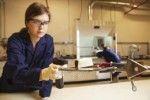Five years of research and testing has advanced a Texas A&M professor and a team of graduate and undergraduate assistants in the direction of engineering a flame retardant technology.
Jaime Grunlan, head of the Department of Mechanical Engineering, along with a team of researchers, has discovered a way to use renewable materials to create an environmentally friendly flame retardant nanocoating to be used on clothing and household furniture.
Grunlan said fabric and foam are both highly flammable and that people are harmed when they catch fire.
There is a big problem these days, because the best flame retardants are highly toxic, Grunlan said.
This new technology would take the place of toxic chemicals traditionally used as anti-flammable agents in common household furniture, improving human health conditions in the home while protecting families and their homes from burning in fires.
Several companies are funding continued research in this field at A&M. The goal is to use the new flame retardant technology in the place of toxic coatings when producing a variety of household products, some of which in the past have posed serious health hazards.
We needed to find flame retardants that are effective, but also safe for both humans and the environment, said post-doctoral research assistant Galina Laufer.
The coatings are made of two water-soluble polymers, one positively charged and one negatively charged. This forms a coating 1,000 times thinner than a typical layer of paint used on houses, earning it the name nanocoating.
The coating is not visible to the eye, nor does it alter the properties of the foam or cotton fibers on which it is used. The coating forms what Laufer refers to as a nano-brick wall between the flame and the coated object.
Though the polymer coating does not make an object 100 percent fireproof, Grunlan said the coating dramatically diminishes the ability of the object to burn.
Grunlan hopes the first application of the polymer coating for commercial use will begin one year from now. However, the largest problem facing companies at this point is inventing and building machines to make and apply the coating on a commercial scale.
By using renewable, water-soluble and dispersible substances found naturally in the environment, Grunlan and his team have found a way to not only prevent objects from catching fire, but also a way to protect families from harmful effects of toxic chemicals.
This new advancement has the potential to greatly impact the way humans fight fire, while at the same time change the makeup of everyday household products, and possibly even save lives.
I wanted to work on this because I saw a great opportunity, Kevin Holder, mechanical engineering graduate assistant said. Not only to get real world results, but also to help keep people safe.
Engineering professor invents technology to combat fire hazards
January 22, 2013

Donate to The Battalion
Your donation will support the student journalists of Texas A&M University - College Station. Your contribution will allow us to purchase equipment and cover our annual website hosting costs.



















